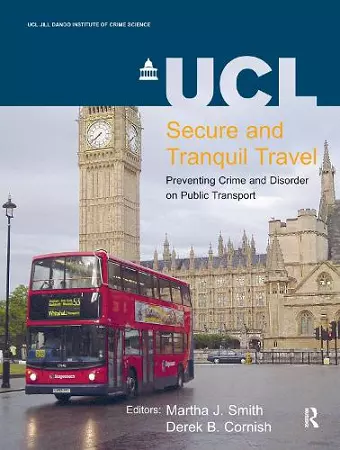Secure and Tranquil Travel
Derek B Cornish editor Martha J Smith editor
Format:Hardback
Publisher:Taylor & Francis Ltd
Published:2nd Feb '17
Currently unavailable, and unfortunately no date known when it will be back
This hardback is available in another edition too:
- Paperback£79.99(9780954560744)

Herein lie the answers to crime and disorder. So many people become dispirited, fatalistic or angry about crime instead of seeing crime problems, like business setbacks, as challenges or even opportunities. This book sets out a clear, systematic and demonstrably successful strategy for reducing the temptations and opportunities for crime. You cannot change the travelling public or the communities which public transport serves, but you can change the immediate circumstances and surroundings that you present to people, you can re-think and reinvigorate your service offering, you can recruit help from other agencies, from staff and even those who ride the system, and you can make the transition from being reactive to being ahead of the game. The theory is backed up by concrete examples of how and why and where smart-thinking has worked before to outflank crime-this is not just off-the-shelf self-help philosophy but a compendium of real-world best practice. What's more, you can often make money, or at least save a lot of money, by doing the right thing, and this book tells you how. Nick Ross,BBC Crimewatch UK, Chairman, UCL Jill Dando Institute of Crime Science Advisory Board
Secure and Tranquil Travel is applied criminology at its best. Written for those with an interest in managing rail, bus, and underground transport services, the book offers what is essentially a step-by-step guide on how to identify and mitigate various kind of crime and disorder on public transit facilities. Using the SARA model (Scanning, Analysis, Response, and Assessment), the contributors examine anti-social behaviour, crimes against passengers, crimes against employees, vandalism and graffiti, and line-of-route crimes. In its entirety, the book is a wonderful resource in the most applied sense. While its pragmatism might be disconcerting for those with an appreciation for critical criminology, the way in which the contributors bring criminological theory, methodological insight, and empirical evidence to bear on real-world problems is intellectually refreshing. Holding the book together is a whole-hearted embrace of opportunity-based theories of crime. With each chapter drawing heavily from advances in rational choice and routine activity theory, situational crime prevention, and Crime Prevention Through Environmental Design, one is treated to a detailed analysis of how the spatial and temporal flow of passengers, staff, and would-be offenders, when combined with an amenable physical environment, can set the stage for crime and disorder. What makes the book particularly interesting is the way it makes criminological theory and research speak to the organizational demands and concerns of the public transportation industry,including issues and/or concerns about staffing, efficiency, ridership, public relations, and revenue generation. Thus, the book will likely catch the interest of those working in the industry. The methodological rigor of Secure and Tranquil Travel is worth noting. Using the SARA model, the authors bring to light just how critically important it is that preliminary research flesh out crime and disorder’s situationally specific characteristics. While acknowledging the problems that inevitably follow from “cookie-cutter†solutions to crime and disorder, the contributors manage to walk that fine line between applying tried-and-true solutions on one hand, and focussing on situational variation on the other. It is this balance that gives the book its sense of cautious, scientific optimism. Although academic reviews rarely comment on a book’s design or layout, I believe it is necessary here. Secure and Tranquil Travel makes extensive and effective use of photography. As a result, problems of crime and disorder are brought to life in their natural settings, offering the reader a unique opportunity to evaluate criminogenic environments in a way that is as close as it gets to an actual site visit. However, the book’s pragmatism is slightly disconcerting in so far as its emphasis on “what might work†leaves little room for more difficult discussions about the cultural politics surrounding crime, disorder, and especially fear. Of course, proponents of situational crime prevention are rarely forthright about such matters, choosing instead to focus exclusively on the criminal event as an a-political phenomenon as opposed to the biographical origins of the offender or the structural causes of criminality. While it might have been difficult to acknowledge the relevance of race, gender, or socio-economic status as critical factors in the aetiology of fear (for example) given the book’s target audience, these issues should have been raised nonetheless. The importance of racism, gender discrimination, and inequality must remain part of the broader discussion when it comes to explaining and perhaps solving issues of crime and disorder. Unfortunately, Secure and Tranquil Travel offers a mere nod in that direction. Finally, a pedagogical note: adopting the book as a required reading in a university setting would be a challenge given its exclusive focus on public transit. That being said, however, the book would make a phenomenal resource for instructors looking to introduce case study material into their lectures and/or seminars and would thereby provide that sense of “hands on†training which so many undergraduate criminology and sociology students seem to appreciate. PATRICK F. PARNABY University of Guelph
ISBN: 9781138176614
Dimensions: unknown
Weight: 600g
238 pages